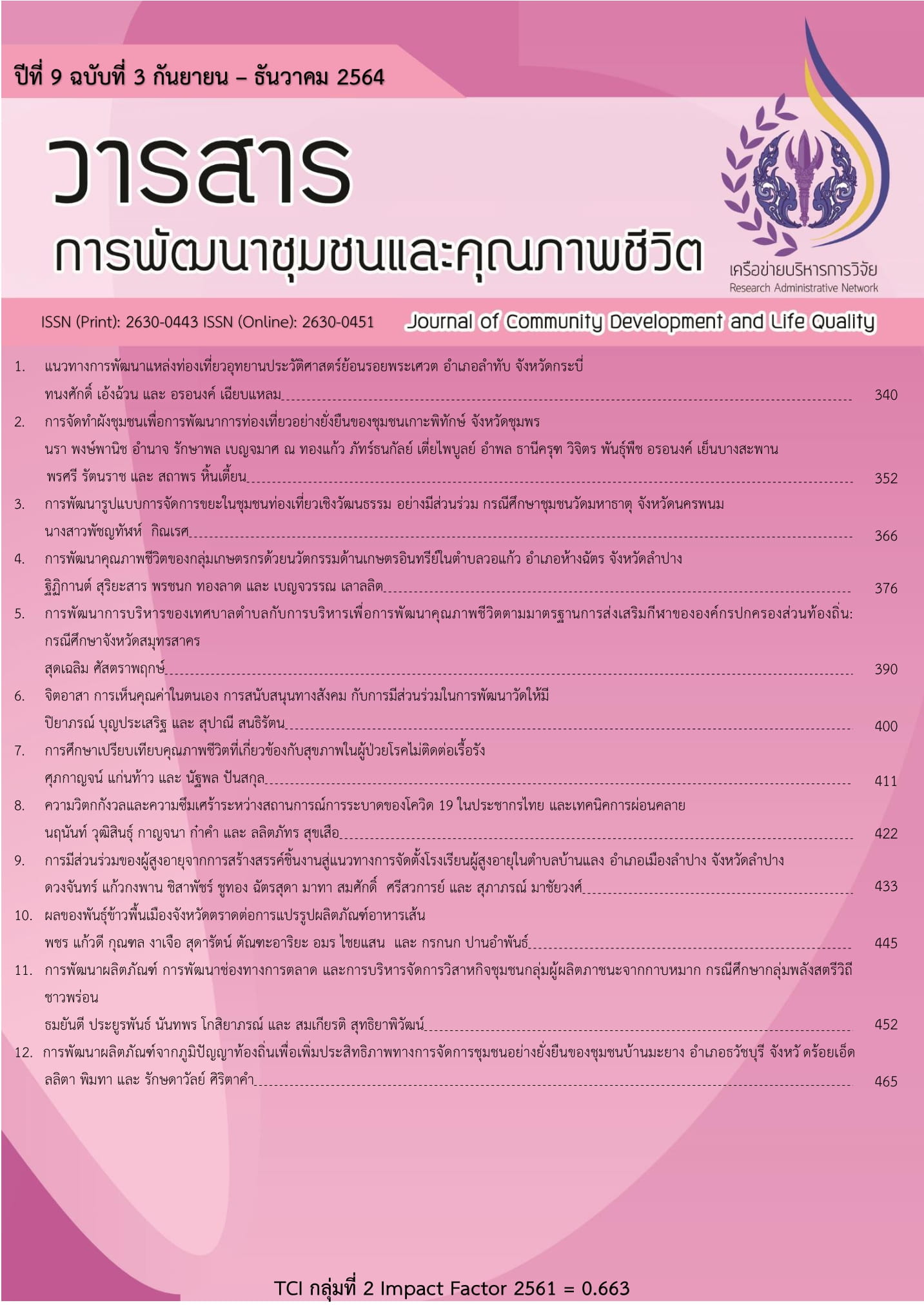การศึกษาเปรียบเทียบคุณภาพชีวิตที่เกี่ยวข้องกับสุขภาพในผู้ป่วยโรคไม่ติดต่อเรื้อรัง
Main Article Content
บทคัดย่อ
การศึกษาวิเคราะห์แบบภาคตัดขวางนี้ เพื่อศึกษาความสามารถในการใช้ชีวิตประจำวัน ระดับคุณภาพชีวิตที่เกี่ยวข้องกับสุขภาพ และเปรียบเทียบคุณภาพชีวิตที่เกี่ยวข้องกับสุขภาพในผู้ป่วยโรคไม่ติดต่อเรื้อรัง กลุ่มตัวอย่างเป็นผู้ป่วยโรคไม่ติดต่อเรื้อรังในจังหวัดแพร่ จำนวน 309 ราย สุ่มตัวอย่างแบบหลายขั้นตอน เก็บรวบข้อมูลโดยใช้แบบสอบถาม 2 ส่วน คือ ส่วนที่ 1 ข้อมูลส่วนบุคคลและความสามารถด้านต่าง ๆ ส่วนที่ 2 แบบประเมินคุณภาพชีวิตที่เกี่ยวข้องกับสุขภาพขององค์การอนามัยโลกฉบับภาษาไทย ผลการศึกษา พบว่า ผู้ป่วยโรคไม่ติดต่อเรื้อรังมีความสามารถในการใช้ชีวิตประจำวันด้านต่าง ๆ ได้แก่ การสื่อสารพูดคุยกับคนอื่น การได้ยินเสียงชัดเจน การมองเห็นสิ่งต่าง ๆ ชัดเจน การทำกิจวัตรประจำวัน และการไปไหนมาไหนด้วยตนเอง อยู่ในระดับพอทำได้ไปจนถึงทำได้ดีมากขึ้น ยกเว้น การเขียนหนังสือและการอ่านหนังสือ ที่มีการประเมินตนเองอยู่ในระดับทำไม่ได้เลยไปจนถึงทำได้ดีมาก ส่วนใหญ่มีคุณภาพชีวิตโดยรวมที่เกี่ยวข้องกับสุขภาพอยู่ในระดับสูง ผู้ป่วยโรคความดันโลหิตสูง ร้อยละ 92.3 ผู้ป่วยโรคเบาหวาน ร้อยละ 87.4 และผู้ป่วยโรคความดันโลหิตสูงร่วมกับโรคเบาหวาน ร้อยละ 88.2 ตามลำดับ ผู้ป่วยโรคความดันโลหิตสูงมีคุณภาพชีวิตโดยรวมที่เกี่ยวข้องกับสุขภาพสูงกว่าผู้ป่วยโรคเบาหวานอย่างมีนัยสำคัญทางสถิติที่ p-value < 0.05 ดังนั้น หน่วยงานที่เกี่ยวข้องควรนำไปใช้เป็นข้อมูลในการตัดสินใจดำเนินโครงการให้เกิดประสิทธิภาพและประสิทธิผล และปรับใช้ให้เหมาะสมกับบริบทของแต่ละพื้นที่ต่อไป
Article Details
กองบรรณาธิการขอสงวนสิทธิ์ในการตรวจและแก้ไขบทความที่เสนอเพื่อตีพิมพ์ในวารสารการพัฒนาชุมชนและคุณภาพชีวิต
บทความหรือข้อความคิดเห็นใด ๆ ที่ปรากฏในวารสารการพัฒนาชุมชนและคุณภาพชีวิต เป็นวรรณกรรมของผู้เขียนโดยเฉพาะคณะผู้จัดทำไม่จำเป็นต้องเห็นด้วย และไม่ใช่ความรับผิดชอบของมหาวิทยาลัยและคณะผู้จัดทำ / บรรณาธิการ
References
Burden of Disease Research Program Thailand. 2014. Disease burden at the regional and regional level of Thailand 2014. Bangkok: The Graphico Systems Co., Ltd. (in Thai)
Department of Mental Health Thailand. World health organization quality of life brief–thai, WHOQOL-BREF-THAI. 2002. (Online). Available: https://dmh.go.th/test/download/files/whoqol.pdf (Jan 13, 2019). (in Thai)
Dhurakij Pundit University Research Center. 2013. Survey of health literacy among the sample population for psychometric analysis to verify accuracy. (Online). Available: https://www.hsri.or.th/researcher/research/new-release/detail/4582 (Nov 3, 2019). (in Thai)
Groessl, E.J., R.M. Kaplan, W.J. Rejeski, J.A. Katula, N.W. Glynn, A.C. King, S.D. Anton, M. Walkup, C.J. Lu, K. Reid, B. Spring and M. Pahor. 2019. Physical activity and performance impact long-term quality of life in older adults at risk for major mobility disability. American Journal of Preventive Medicine 56(1): 141-146.
Health Systems Research Institute Thailand. 2014. Report of the 5 th Thai people's health survey by physical examination 2014. (Online). Available: https://www.hsri.or.th /researcher/research/newrelease/detail/7711 (Jan 20, 2019). (in Thai)
Kongsomboon K. 2014. Epidemiological research textbooks for medical students. Bangkok: CU Print. (in Thai)
Mata, A.R.D., J. Álvares, L.M. Diniz, M.R.R.D Silva, B.R.A.D Santos, A.A.G Júnior, M.L. Cherchiglia, E.I.G. Andrade, B. Godman and F.D.A Acurcio. 2016. Quality of life of patients with diabetes mellitus types 1 and 2 from a referral health center in Minas Gerais, Brazil. Expert Review of Clinical Pharmacology 9(5): 739-746.
Nutbeam, D. 2000. Health literacy as a public health goal: a challenge for contemporary health education and communication strategies into the 21st century. Health promotion international 15(3): 259-67.
Ose, D., M. Wensing, J. Szecsenyi, S. Joos, K. Hermann and A. Miksch. 2009. Impact of primary care–based disease management on the health-related quality of life in patients with type 2 diabetes and comorbidity. Diabetes Care 32(9): 1594-1596.
Pragodpol, P., Y. Suwannaka, A. Chairit, B. Sosom, S. Seethan, M. Soisrisawat and S. Janpong. 2015. Levels of quality of life and method to develop quality of life in Thai chronically ill patients. (Research Report). Nonthaburi: Health Systems Research Institute. (in Thai)
Roma, V., M. Somnuankwang and S. Koyeym. 2009. Health knowledge survey of Thai people aged 15 and over 2017 (phase 1). (Research Report). Nonthaburi: Health Systems Research Institute. (in Thai)
Rwegerera, G.M., T. Moshomo, M. Gaenamong, T.A. Oyewo, S. Gollakota, Y.P. Rivera and D. Habte. 2018. Health-related quality of life and associated factors among patients with diabetes mellitus in Botswana. Alexandria Journal of Medicine 54(2): 111-118.
Singchongchai, P. 2013. QALYs: Economic health indicator of life quality. AL-Nur Journal of Graduate School, Fatoni University 8(14): 1-8. (in Thai)
Solli, O., K. Stavem and I.S. Kristiansen. 2010. Health-related quality of life in diabetes: the associations of complications with EQ-5D scores. Health and Quality of Life Outcomes 8(1): 18.
Srivanichakarn, S. 2017. Morbidity and mortality situation of non-communicable diseases (diabetes type 2 and cardiovascular disease) in Thailand during 2010-2014. Disease Control Journal 43(4): 379-390. (in Thai)
Thai Hypertension Society. 2019. Hypertension. (Online). Available: http://www.thaihypertension.org/information.html (May 20, 2019). (in Thai)
Weber, M.A., E.L. Schiffrin, W.B. White., S. Mann, L.H. Lindholm, J.G. Kenerson. and D.L. Cohen. 2014. Clinical practice guidelines for the management of hypertension in the community: a statement by the american society of hypertension and the international society of hypertension. The Journal of Clinical Hypertension 16(1): 14-26.
World Health Organization. 2018. Non-communicable diseases. (Online). Available: https://www.who.int/news - room/fact-sheets/detail/noncommunicable-diseases (Mar 13, 2019)
Wungrath, J., S. Saengyo and K. Ummee. 2018. Barriers to health care practice that impact to glycemic control among elderly with diabetes mellitus. Journal of Community Development and Life Quality 6(2): 351-361. (in Thai)

